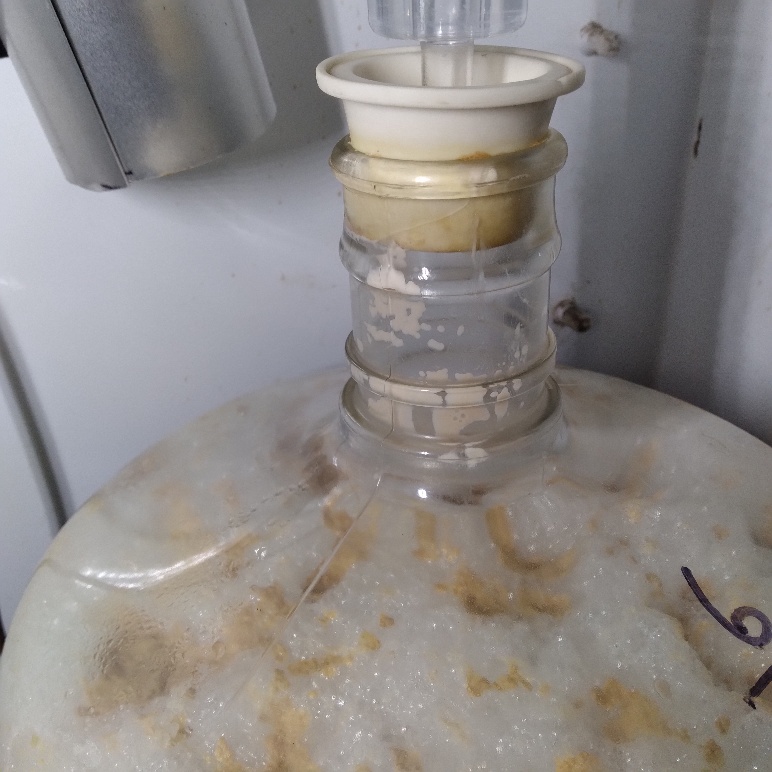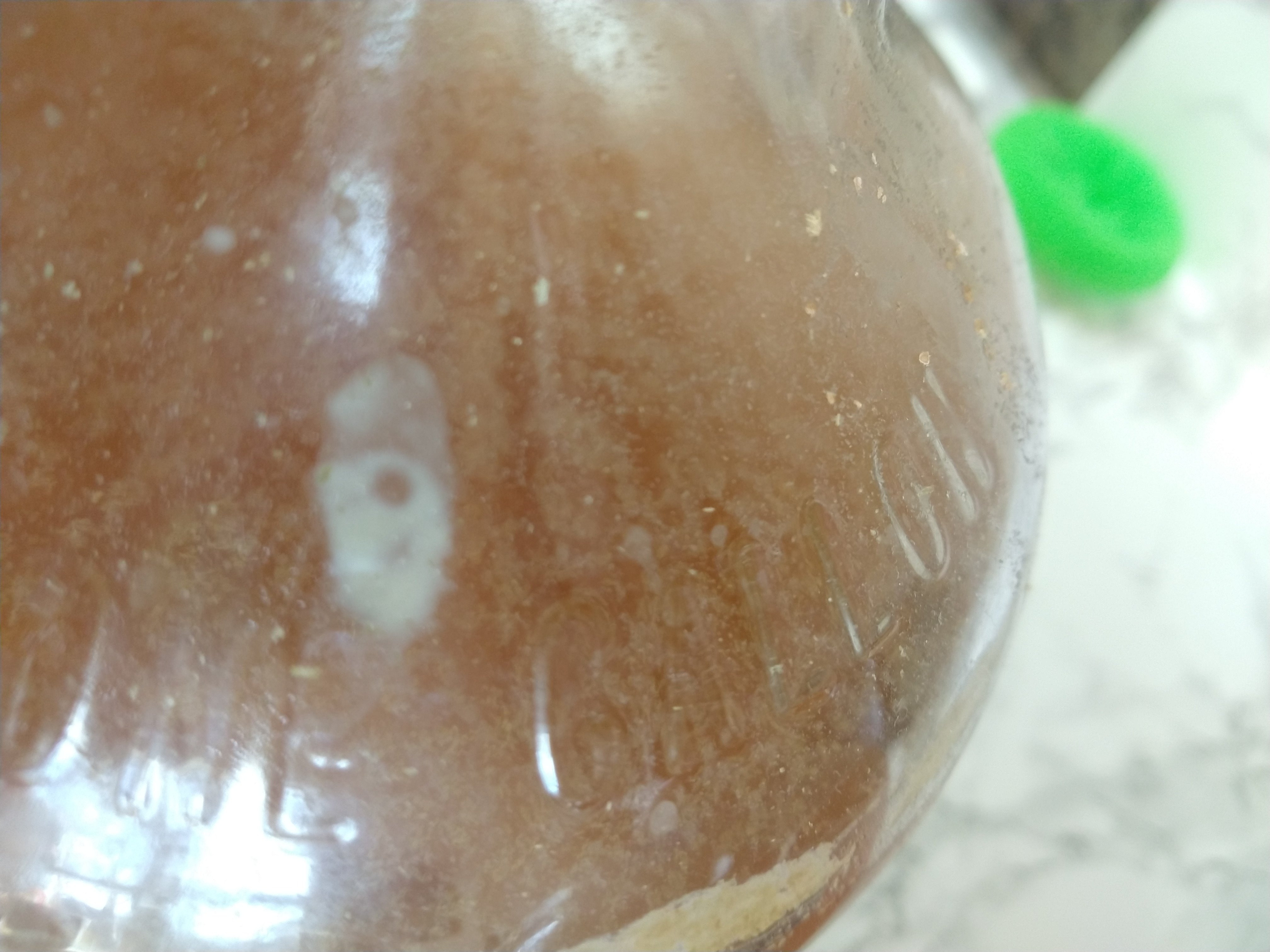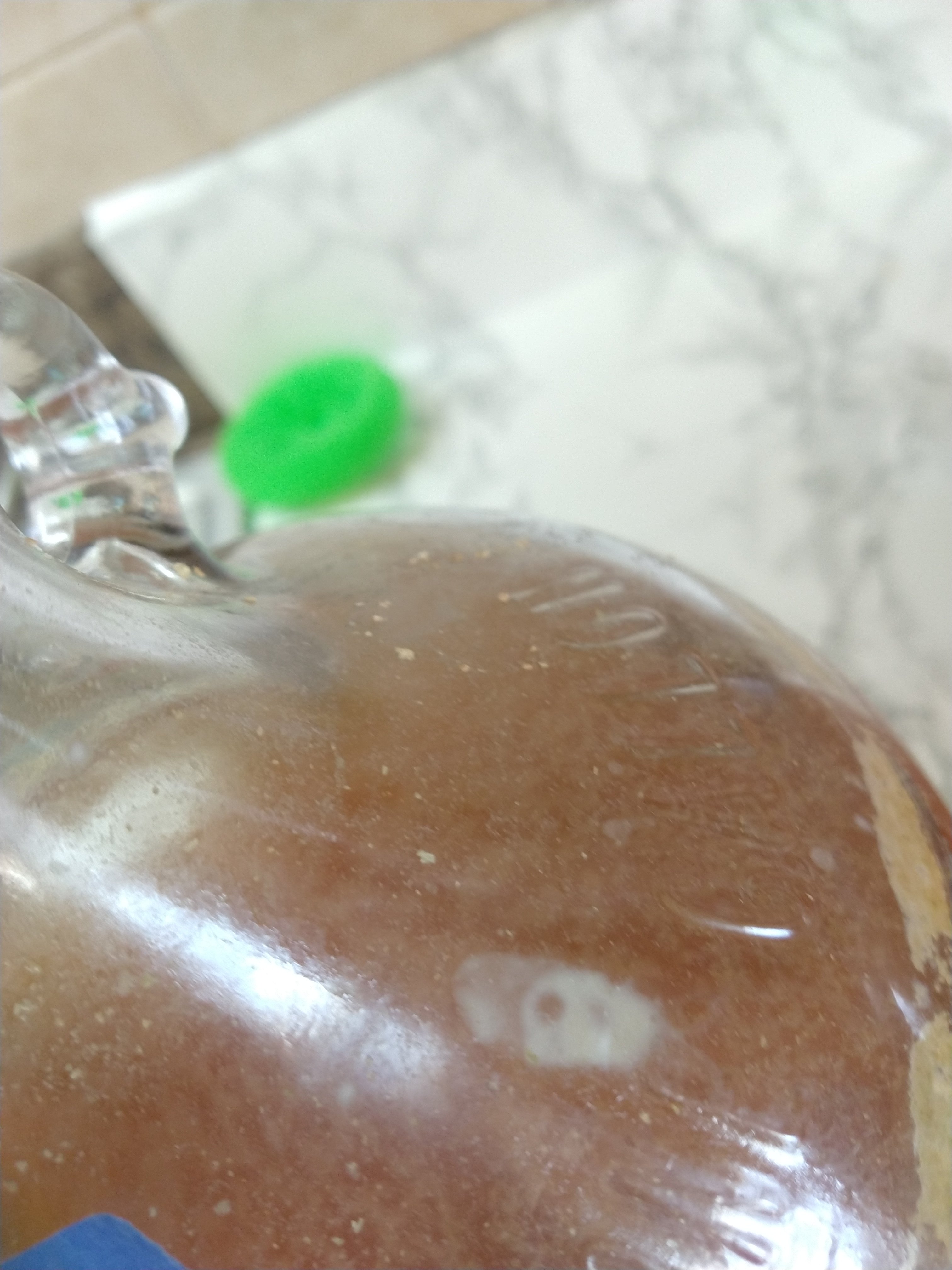You are using an out of date browser. It may not display this or other websites correctly.
You should upgrade or use an alternative browser.
You should upgrade or use an alternative browser.
Is this mold in my carboy?
- Thread starter Ariel
- Start date

Help Support Homebrew Talk:
This site may earn a commission from merchant affiliate
links, including eBay, Amazon, and others.
Looks like yeast. Did you sprinkle dry yeast in there?
Yes. I sprinkled onto the surface of the wort. It could have gotten stuck to the glass when I was shaking it all up to add oxygen. It's hasn't happened to my other brews I've made but this only my 5th timeLooks like yeast. Did you sprinkle dry yeast in there?
I agree with Nick. I use dry yeast and see that all the time. This is the batch that’s currently in my ferm fridge.


Be careful sanitizing glass carboys with boiling water. They can break from thermal shock.
I first fill them with warm tap water and increase the temp. Wait till it's all hot and then add boiling water. I've had too many glass break on me so I'm extra cautiousBe careful sanitizing glass carboys with boiling water. They can break from thermal shock.

$479.00
$559.00
EdgeStar KC1000SS Craft Brew Kegerator for 1/6 Barrel and Cornelius Kegs
Amazon.com

$39.22 ($39.22 / Count)
Brewer's Best Home Brew Beer Ingredient Kit - 5 Gallon (Mexican Cerveza)
Amazon.com

$53.24
1pc Hose Barb/MFL 1.5" Tri Clamp to Ball Lock Post Liquid Gas Homebrew Kegging Fermentation Parts Brewer Hardware SUS304(Liquid Hose Barb)
yunchengshiyanhuqucuichendianzishangwuyouxiangongsi

$33.99 ($17.00 / Count)
$41.99 ($21.00 / Count)
2 Pack 1 Gallon Large Fermentation Jars with 3 Airlocks and 2 SCREW Lids(100% Airtight Heavy Duty Lid w Silicone) - Wide Mouth Glass Jars w Scale Mark - Pickle Jars for Sauerkraut, Sourdough Starter
Qianfenie Direct

$176.97
1pc Commercial Keg Manifold 2" Tri Clamp,Ball Lock Tapping Head,Pressure Gauge/Adjustable PRV for Kegging,Fermentation Control
hanhanbaihuoxiaoshoudian

$22.00 ($623.23 / Ounce)
AMZLMPKNTW Ball Lock Sample Faucet 30cm Reinforced Silicone Hose Secondary Fermentation Homebrew Kegging joyful
无为中南商贸有限公司

$58.16
HUIZHUGS Brewing Equipment Keg Ball Lock Faucet 30cm Reinforced Silicone Hose Secondary Fermentation Homebrew Kegging Brewing Equipment
xiangshuizhenzhanglingfengshop

$10.99 ($31.16 / Ounce)
Hornindal Kveik Yeast for Homebrewing - Mead, Cider, Wine, Beer - 10g Packet - Saccharomyces Cerevisiae - Sold by Shadowhive.com
Shadowhive

$20.94
$29.99
The Brew Your Own Big Book of Clone Recipes: Featuring 300 Homebrew Recipes from Your Favorite Breweries
Amazon.com

$7.79 ($7.79 / Count)
Craft A Brew - LalBrew Voss™ - Kveik Ale Yeast - For Craft Lagers - Ingredients for Home Brewing - Beer Making Supplies - (1 Pack)
Craft a Brew

$53.24
1pc Hose Barb/MFL 1.5" Tri Clamp to Ball Lock Post Liquid Gas Homebrew Kegging Fermentation Parts Brewer Hardware SUS304(Gas MFL)
Guangshui Weilu You Trading Co., Ltd
![Craft A Brew - Safale S-04 Dry Yeast - Fermentis - English Ale Dry Yeast - For English and American Ales and Hard Apple Ciders - Ingredients for Home Brewing - Beer Making Supplies - [1 Pack]](https://m.media-amazon.com/images/I/41fVGNh6JfL._SL500_.jpg)
$6.95 ($17.38 / Ounce)
$7.47 ($18.68 / Ounce)
Craft A Brew - Safale S-04 Dry Yeast - Fermentis - English Ale Dry Yeast - For English and American Ales and Hard Apple Ciders - Ingredients for Home Brewing - Beer Making Supplies - [1 Pack]
Hobby Homebrew
hotbeer
Opinionated Newb
- Joined
- Mar 10, 2021
- Messages
- 3,090
- Reaction score
- 2,809
The when the krausen is very active you can watch an see that almost all the trub gets churned back into suspension. That and yeast get left on the sides up in the headspace.
Mold I'd expect to be black or blackish-green and fuzzy.
If using dry yeast, most tell you that aerating the wort is unnecessary. I stopped shaking my gallon fermenters quite a few batches ago and they do as good as they ever did with aeration. Maybe better.
Mold I'd expect to be black or blackish-green and fuzzy.
If using dry yeast, most tell you that aerating the wort is unnecessary. I stopped shaking my gallon fermenters quite a few batches ago and they do as good as they ever did with aeration. Maybe better.
Interesting. How come with dry you stop shaking?The when the krausen is very active you can watch an see that almost all the trub gets churned back into suspension. That and yeast get left on the sides up in the headspace.
Mold I'd expect to be black or blackish-green and fuzzy.
If using dry yeast, most tell you that aerating the wort is unnecessary. I stopped shaking my gallon fermenters quite a few batches ago and they do as good as they ever did with aeration. Maybe better.
hotbeer
Opinionated Newb
- Joined
- Mar 10, 2021
- Messages
- 3,090
- Reaction score
- 2,809
Because it's not needed for most dry yeast. Things a little over my 9th grade biology education involved. But I've done my last four brews without aerating and they did fine. Well, two of them are still in the fermenter, but they krausened as well as any.Interesting. How come with dry you stop shaking?
https://fermentis.com/en/knowledge-center/qanda/Can you clarify if it is correct that no oxygenation is needed or not for your dry yeasts? And would there a difference between lagers and ales on this?
We don’t recommend aerating the wort in normal conditions. The dry yeast has been produced and dried with a specific know-how of the Lesaffre Group, in order to maximize the Ergosterols content of the cells. This allows the yeast to grow/multiply and ferment well.However, you could aerate the wort in particular cases, for example if you recycle the yeast. There is no difference (for the O2) between Ale and Lager.
If your recipe says to aerate, it might be because you had a choice of liquid and dry yeast when you bough it and they are just covering their bases and not trying to confuse you with one needing aerating and the other not.
Or it's just because the current recipe wasn't updated to the current thinking for that kit if only came with dry.
If you are using kits that don't tell you what yeast they are giving you, then I'd throw that yeast away and get a known brand of yeast appropriate for the beer you are making. It made a big difference for me when I was still buying ingredient kits that had an unbranded packet of dry yeast in them that was just identified by the name "Yeast".
Because it's not needed for most dry yeast. Things a little over my 9th grade biology education involved. But I've done my last four brews without aerating and they did fine. Well, two of them are still in the fermenter, but they krausened as well as any.
https://fermentis.com/en/knowledge-center/qanda/
If your recipe says to aerate, it might be because you had a choice of liquid and dry yeast when you bough it and they are just covering their bases and not trying to confuse you with one needing aerating and the other not.
Or it's just because the current recipe wasn't updated to the current thinking for that kit if only came with dry.
If you are using kits that don't tell you what yeast they are giving you, then I'd throw that yeast away and get a known brand of yeast appropriate for the beer you are making. It made a big difference for me when I was still buying ingredient kits that had an unbranded packet of dry yeast in them that was just identified by the name "Yeast".
Thanks. It looks like it was just yeast.
I wasn't following a recipe steps. I was making the Milo 8 recipe for blue moon clone. My first videos I watched to learn to make beer said to shake the bottle to aerate and mix in the dry yeast. I think I will swap to aerating before I add the yeast. Then I either let the yeast soak up the liquid and fall or gently stir to get them to mix in.
hotbeer
Opinionated Newb
- Joined
- Mar 10, 2021
- Messages
- 3,090
- Reaction score
- 2,809
Okay, but just realize that you don't have to do any of that with most dry yeast pitched from it's packet. Aerating and shaking doesn't help it that much if any.Thanks. It looks like it was just yeast.
I wasn't following a recipe steps. I was making the Milo 8 recipe for blue moon clone. My first videos I watched to learn to make beer said to shake the bottle to aerate and mix in the dry yeast. I think I will swap to aerating before I add the yeast. Then I either let the yeast soak up the liquid and fall or gently stir to get them to mix in.
Unless you just like the fun of doing that stuff... which is just more brew day complication to me.
If you re-use yeast that was once dry yeast, you do need to aerate the wort.
There is a lot of dogma in home brewing that keeps us doing stuff that was once necessary but now is not necessary and maybe even detrimental. Though I don't think this is one of those things that is wrong or right either way you go.
Okay, but just realize that you don't have to do any of that with most dry yeast pitched from it's packet. Aerating and shaking doesn't help it that much if any.
Unless you just like the fun of doing that stuff... which is just more brew day complication to me.
If you re-use yeast that was once dry yeast, you do need to aerate the wort.
There is a lot of dogma in home brewing that keeps us doing stuff that was once necessary but now is not necessary and maybe even detrimental. Though I don't think this is one of those things that is wrong or right either way you go.
Why do you say aerating doesn't do much? Im open to stopping it if its not needed and saves time
It's because the manufacturer of the yeast says it is packed with all it needs to propagate which is what oxygen does for liquid yeast.Why do you say aerating doesn't do much? Im open to stopping it if its not needed and saves time
It's because the manufacturer of the yeast says it is packed with all it needs to propagate which is what oxygen does for liquid yeast.
Is that the same for dry yeast? I only use dry yeast for now. Mainly US-05 and have Us-04 for when I finish the us-05
hotbeer
Opinionated Newb
- Joined
- Mar 10, 2021
- Messages
- 3,090
- Reaction score
- 2,809
It's only for dry yeast as we've said several times. And only when pitched the first time. Not if you re-use slurry from one batch for another.
Look at the FAQ or sometimes in the specs of your yeasts manufacturer and you'll find that info.
If you are buying a kit that simply has a non-descript packet marked "yeast" then do what the recipe says. Though I started throwing that non-descript packet away and used a known dry yeast, US-05 for my last batches. Now I no longer buy kits.
https://fermentis.com/en/knowledge-center/qanda/
Look at the FAQ or sometimes in the specs of your yeasts manufacturer and you'll find that info.
If you are buying a kit that simply has a non-descript packet marked "yeast" then do what the recipe says. Though I started throwing that non-descript packet away and used a known dry yeast, US-05 for my last batches. Now I no longer buy kits.
https://fermentis.com/en/knowledge-center/qanda/
Similar threads
- Replies
- 8
- Views
- 705

















































